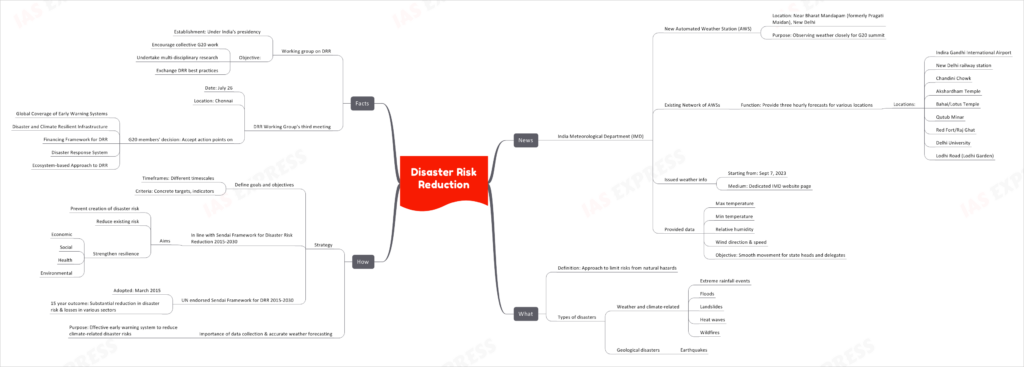Disaster Risk Reduction

With an increase in climate change-related challenges, Disaster Risk Reduction (DRR) becomes paramount. India, recognizing the importance, is making significant strides in weather prediction and collaborative global efforts.
This topic of “Disaster Risk Reduction” is important from the perspective of the UPSC IAS Examination, which falls under General Studies Portion.
Latest News
India Meteorological Department (IMD) Takes the Helm
IMD has inaugurated a new Automated Weather Station (AWS) near Bharat Mandapam, formerly known as Pragati Maidan, in New Delhi. This installation aims to monitor the weather meticulously in light of the G20 summit.
Moreover, IMD’s extensive network of AWSs is already serving various significant locations in New Delhi. These stations provide three-hourly forecasts for areas such as Indira Gandhi International Airport, New Delhi railway station, and various iconic sites in the city. Starting from September 7, 2023, weather data will be publicly available on a dedicated IMD website page. The data will encompass metrics like maximum and minimum temperature, relative humidity, and wind direction & speed. All these efforts converge to ensure a seamless movement for state heads and delegates.
Deep Dive: What is DRR?
Definition: DRR is a proactive approach designed to minimize risks stemming from natural calamities.
Types of Disasters: DRR majorly deals with:
- Weather and Climate-Related Disasters:
- Extreme rainfall events
- Floods
- Landslides
- Heatwaves
- Wildfires
- Geological Disasters:
- Earthquakes
How is DRR Effected?
The strategy for DRR is multi-faceted:
- Setting Clear Objectives: DRR approaches are pinned on well-defined goals, which are further quantified using concrete targets and indicators.
- Alignment with International Standards: The Sendai Framework for Disaster Risk Reduction 2015-2030, endorsed by the UN and adopted in March 2015, provides a blueprint. Its principal goal over the 15-year timeframe is to achieve a significant reduction in disaster risk & losses across various domains.
- Crucial Role of Data: Data collection, especially accurate weather forecasting, is the backbone of DRR. A robust early warning system can curtail risks from climate-induced disasters.
Notable Facts
- Working Group on DRR: Established under India’s presidency, its primary purpose is to spur collective G20 work, stimulate multi-disciplinary research, and facilitate the exchange of DRR best practices.
- DRR Working Group’s Milestone Meeting: On July 26, in Chennai, G20 members convened for the DRR Working Group’s third meeting. Here, they reached a consensus on key action points such as:
- Global Coverage of Early Warning Systems
- Disaster and Climate Resilient Infrastructure
- Financing Framework for DRR
- Disaster Response System
- Ecosystem-based Approach to DRR

